If you've found yourself Googling "what is work to charge ratio?" I'm here to help.
Work to Charge Ratio is the comparison of how much time your robots spend working versus how much time they spend charging.
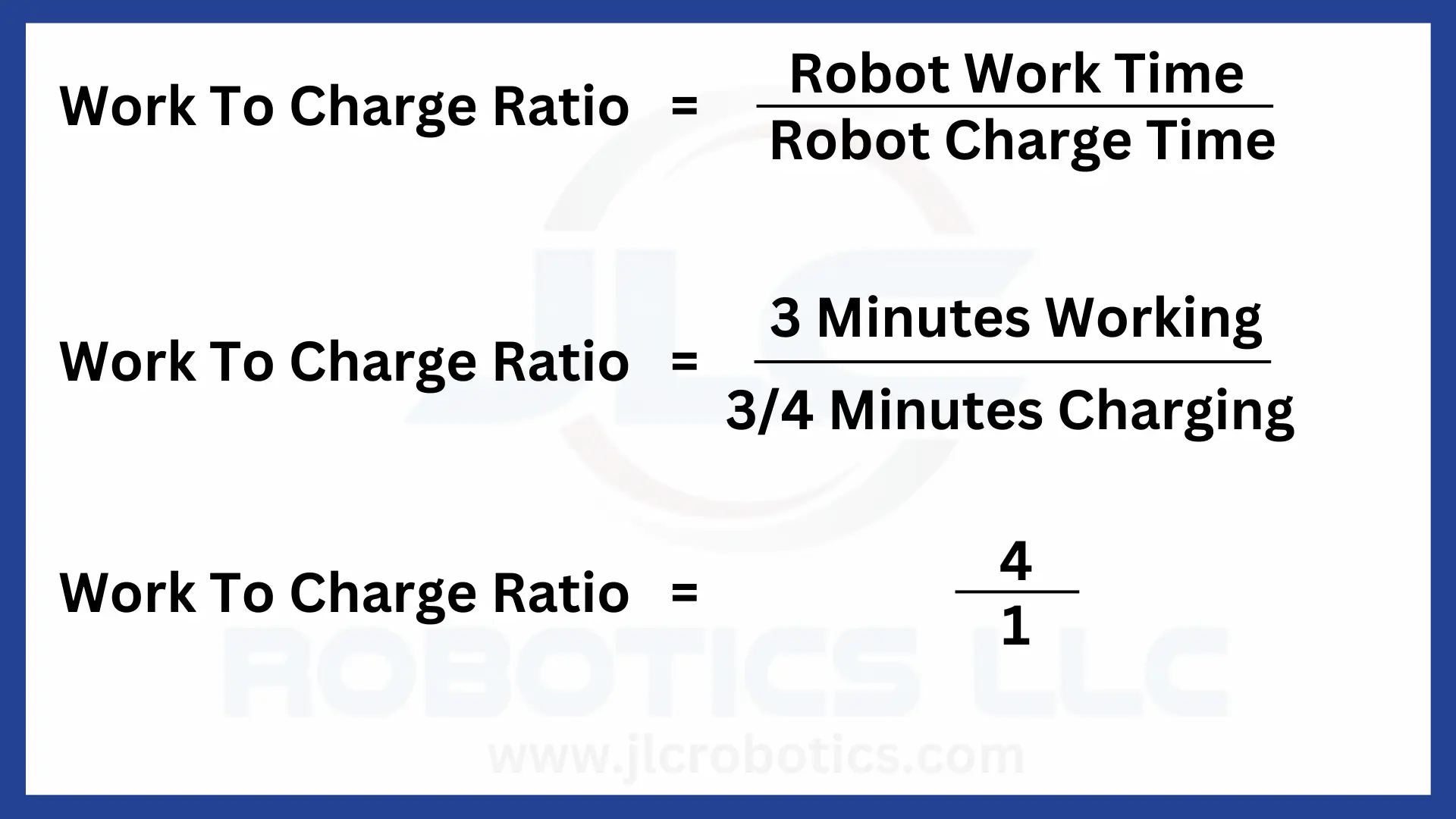
But that's just the tip of the iceberg. You need to know a bit more if you really want to maximize the efficiency of your robot fleet.
That's why I've created this comprehensive guide. If you want to hop to a specific topic, use the table of contents to jump right in.
Work to Charge Ratio in 60 Seconds or Less
Why is Work to Charge Ratio Important?
Optimizing Work to Charge Ratio in High-Demand Production Environments
Work to Charge Ratio in 60 Seconds or Less
There's a lot to learn about Work to Charge Ratio, but I hit the highlights here.
- Work to Charge Ratio is the measure of how much time a robot spends working compared to how much time it spends charging.
- To calculate Work to Charge ratio, divide working time by charging time.
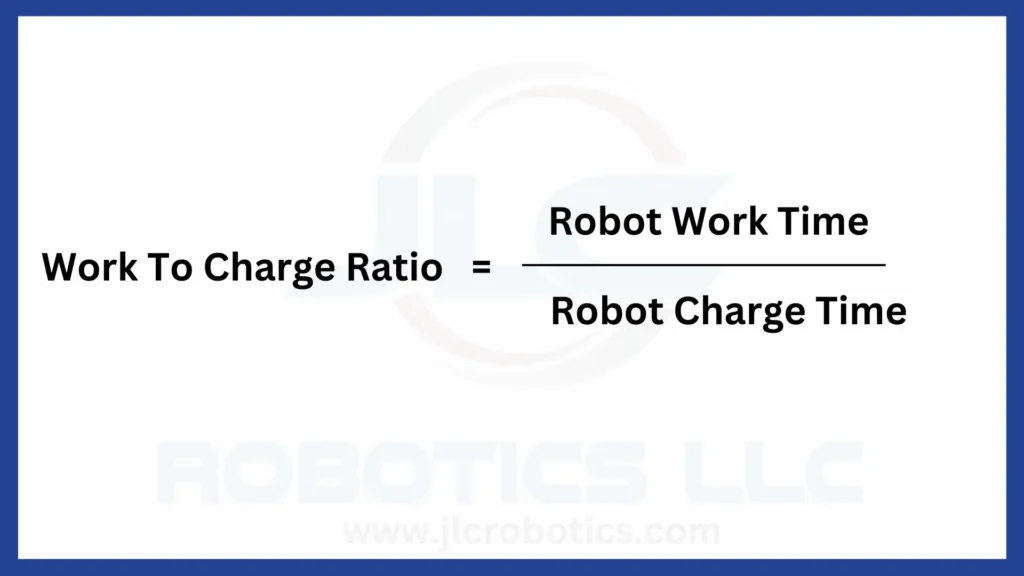
- For example, a robot working 4 hours then charging for 1 hour has a work to charge ratio of 4:1.
- A robot working 4 minutes then charging for 1 minute also has a work to charge ratio of 4:1.
- If you convert these numbers to a percentage, you'll find that the robot works 80% of the time and charges 20% of the time.
- In the case of a robot fleet, the same Work to Charge Ratio means 80% of the fleet works while 20% 'rests'.
- There are many causes for robot downtime, but downtime due to charging is the single largest productivity killer in an AMR or AGV fleet.
- Eliminating downtime due to charging can cut the size of a robot fleet by 25% or more.
- There are many ways to improve your Work to Charge ratio. In simple cases, a battery upgrade might solve your problems. In 24x7 operations, a perpetual power solution like CaPow Genesis can keep your AMR or AGV fleet running non-stop.
Learn More About CaPow
Want to learn more about CaPow and what perpetual power can do for your robot fleets?
What Is Work to Charge Ratio?
As I said in the introduction, Work to Charge Ratio is a measure of the time a robot (or robot fleet!) spends working compared to the time it spends charging.
To calculate work to charge ratio, just divide working time by charging time.

For example, one robot that works for four hours then charges for one hour has a work to charge ratio of 4:1 (four to one).
A 50-robot fleet with 40 working robots and 10 charging robots also has a work to charge ratio of 4:1 (four to one).
How do I Measure Robot Work Time and Charge Time?
Some fleet managers already provide this information. You probably won't see "work to charge ratio" in the GUI, but any utilization statistics that show charging time or charging cycles will work.
Sometimes the information will appear as a simple graph showing battery/charge level of your fleet. Here's a real-world example where five identical robots run the same mission.
The red robot already has an upgraded wireless charging system so just ignore him for now and focus on the others.
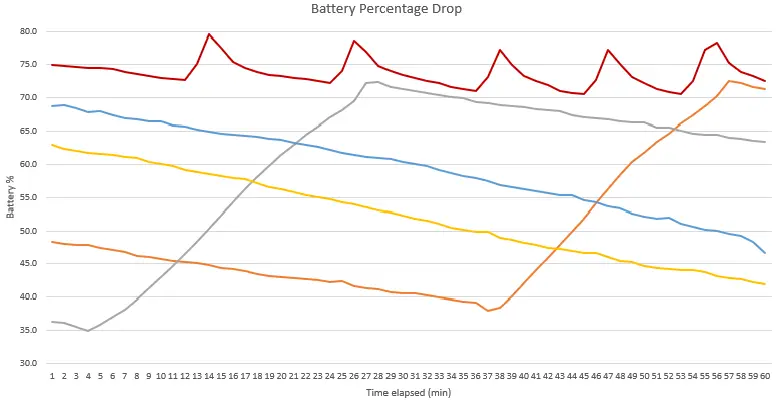
I won't bore you with the math, but on average, the gray and orange robots have a charge time of 22 minutes. They start at ~36% and charge to about ~72%.
In the hour we can see them running, the yellow and blue robot batteries drop about 22%. At that rate, they'd run for about 98 minutes before they need to recharge from 36% to 72%.
work time / charge time = work to charge ratio
98 minutes work / 22 minutes charge = 4.45:1
If we could 'zoom out' on the utilization graph above, it would be easier to calculate these numbers. Regardless. the math isn't too challenging here.
Why is Work to Charge Ratio Important?
Because optimizing your Work to Charge Ratio increases fleet efficiency and saves you money!
Fleet Efficiency
Let's continue with our example - a four-robot fleet with a work to charge ratio of 4.45:1. A ratio of 4.45:1 means:
- The robots spend 4.45x more time working than they do charging.
- If we convert the ratio to a percentage, we find that the robots are doing meaningful work 82% of the time and charging (not working) for 18% of the time.
- If we can eliminate the downtime due to charging, increasing work time from 82% to 100%, the fleet's work output would increase by 22%.
Cost Savings
I spoke with a manufacturer last year that was planning a big automation project. To fully automate all their processes, this company needed 100 AMRs that each cost $40,000 dollars.
100 Robots * $40,000 = $4,000,000 USD
So the proposed cost of this project was $4 million dollars... before factoring in downtime due to charging.
The robot manufacturer estimated this manufacturer would need an extra thirty robots to account for downtime due to charging.
30 Extra Robots * $40,000 = $1,200,000 Extra USD
So the $4 million dollar robot project turned into a $5.2 million dollar robot project just because of downtime due to charging.
And was just the cost of the robots - don't forget about charging docks, batteries, deployment services, integration services, and all the other overhead that will drive the price up even further!
Thankfully, this is overage is avoidable. If you can keep 100% of your fleet running 100% of the time, you'll never have to buy extra robots to account for downtime due to charging again.
And yes, while we are examining the cost of a new fleet here, the numbers hold true for existing robots as well. It's almost always cheaper to improve the work to charge ratio of your existing robots than it is to buy more new ones.
How to Improve Work to Charge Ratio
There are lots of ways to improve a robot's work to charge ratio so we've separated our recommendations into two sections:
- High-demand production environments - 24x7 operations where downtime is very expensive.
- Low-demand production environments - companies that don't run three shifts or have a fixed takt time.
Optimizing Work to Charge Ratio in High-Demand Production Environments
Robots are expensive but downtime is more expensive. Here's how to avoid overspending on both.
Opportunistic Charging
Remember for a moment the goal of this article is to help you optimize your Work to Charge Ratio so you can eliminate downtime due to charging.
We do that by measuring work time against charge time, but this doesn't show us the whole picture of your robots' actual productivity.
- What if the robot has to drive away from the production area to get to its charger?
- How long does it take your robot to dock with its charger once it's arrived to the charging area?
- Does the robot keep working through lunch, breaks, and shift changes?
- What if the robot is sitting still, just waiting to be loaded?
These are all cases where the robot looks like it's working because it's discharging the battery, but it's not actually delivering value to your operation.
The way to fix this is opportunistic charging. Let your robots "take a break" and charge when they're otherwise idle during their normal cycle. Here are some ideas to get you started:
- Put chargers as close to the production process as possible to decrease travel time. Putting chargers in the robot's regular path is best!
- Design charging cycles so they align with personnel breaks to take advantage of human downtime - use this time to recharge instead of discharging your robots.
Most AMRs already take advantage of opportunistic charging but that doesn't mean there's not optimization to be done in your charging setup.
Wireless Charging
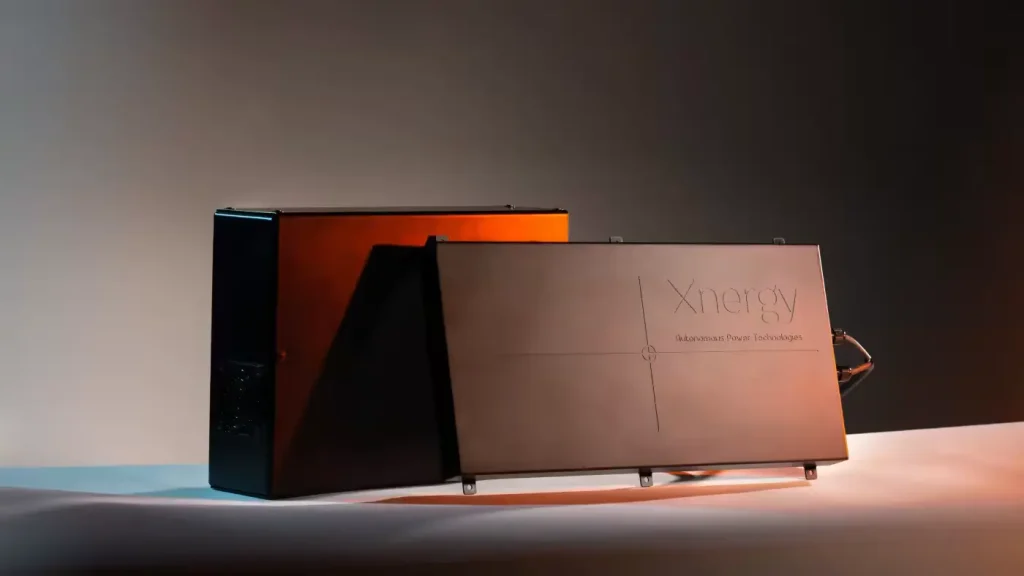
Opportunistic charging is great, but it's very challenging to install industrial robot chargers along the robots' path unless they're wireless.
Some robot OEMs recommend dedicating over 100 square feet to a single charging dock. Good luck finding that much open space near a production line!
Industrial wireless chargers like the Xynergy charger pictured above offer wireless fast charging and very flexible mounting options.
Perpetual Power

When your robots just don't sit still long enough for regular wireless charging to keep them running 24x7, then CaPow Genesis is the way to go.
Unlike other stationary wireless chargers, Genesis charges your robots while they sit still AND it's the only solution I've seen that lets your robots charge while they move. Couple that with the extremely fast docking and lock-on, and you've got a winning solution.
Ultimately, CaPow Genesis is the only solution that guarantees 100% uptime for 100% of your fleet, so if downtime due to charging is killing your productivity, we should probably talk.
Learn More About CaPow
Want to learn more about CaPow and what perpetual power can do for your robot fleets?
Other Ways to Improve Work to Charge Ratio
If your facility is not yet fully automated and can tolerate some robot downtime due to charging or operator intervention, here are a few really cost-effective ways to increase the Work to Charge Ratio of your robot fleet.
Hot-Swappable Batteries

Hot-swappable batteries are like having a cheat code to the work to charge ratio.
The work to charge ratio formula assumes your robot can either work OR charge, but not do both at the same time.
With Hot-Swappable batteries, the work to charge formula breaks because you can charge several "backup" batteries while the robot works, then quickly change them out as needed.
No more stopping to charge!
All you have to do is stop the robot long enough to swap batteries, which means you can keep running almost 24x7.
Note: Hot-swappable batteries is a very uncommon feature among mobile robots today. Most robot manufacturers don't want you messing with their power systems but it's worth asking if this feature is supported.
External Power Packs
If your robot doesn't support hot-swappable batteries, maybe you can use an external power pack to extend battery life instead.

For example, the external power pack above more than triples the runtime (and work to charge ratio) of a standard Thouzer and you can find them on Amazon for about $1100. This solution typically only works for smaller robots though.
Upgrade Your Batteries
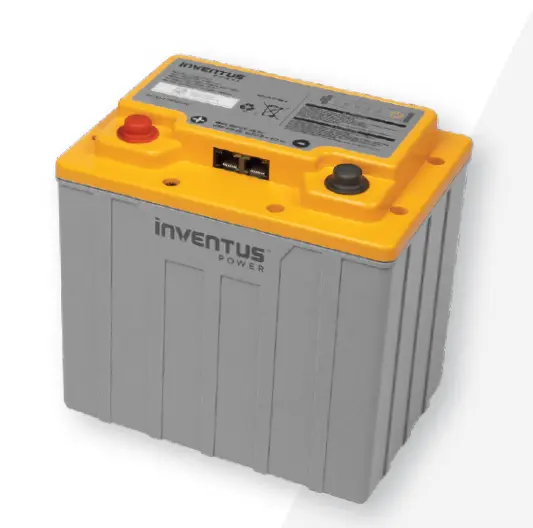
Remember - battery capacity doesn't help your work to charge ratio, so if you're looking into battery upgrades, you should be looking for:
- A high max charge rate first, then
- Capacity, and finally
- Battery lifespan.
Generally speaking, if you have lead-acid batteries today, upgrading to lithium ion or some other fast-charging technology will drastically improve your work to charge ratio.
Not only do lithium batteries charge faster than lead-acid, but they also offer a better depth-of-discharge as well, which means more of the battery's capacity is available to do actual work. Just make sure you do your due diligence to make sure your robot can handle different battery types/sizes.
Upgrade Your Battery Chargers

If you upgrade your batteries you might need to upgrade your battery chargers at the same time. Just make sure you find a charger that matches your (new) battery type.
Remember - faster is better, but follow all OEM (battery, charger, and robot) recommendations and limitations along the way! Don't fry your robot!!!
Optimize Your Charging Process
Most robots with a fleet manager take care of this for you, but if you are responsible for configuring your robot charging cycles, you can probably do some tuning to optimize your work to charge ratio.
Why? Because robots and their batteries generally don't charge in a straight line.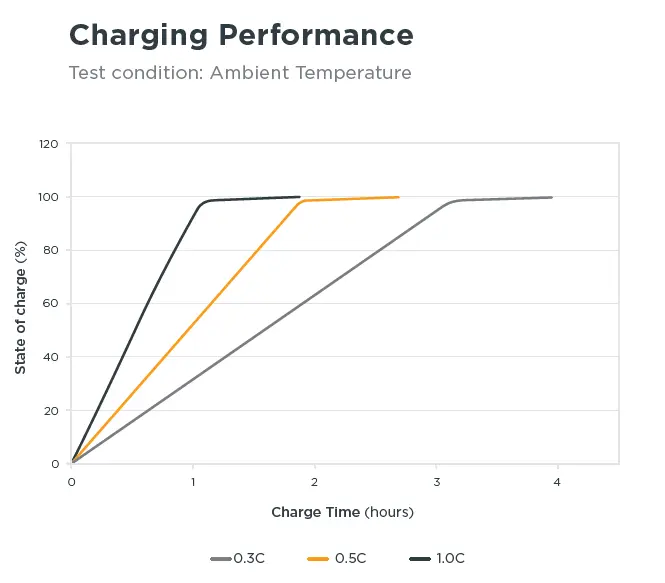
As you can see from the example above, if we charge this battery at 1C, it takes the same amount of time to charge from 0 to 95% as it does to charge from 95% to 100%. Don't wait an hour for that extra 5%!
Every battery has its own charging curve so you have to figure out when your batteries charges fastest and then build your charging cycles around that.
Final Notes
There are lots of ways to maximize your work to charge ratio and squeeze every last bit of efficiency out of your mobile robots and I hope this article has given you some ideas for how to optimize your own facility.
If you still need help or think I've missed something here, please leave a comment below or contact me to let me know. I do check comments and form submissions regularly!
Learn More About CaPow
Want to learn more about CaPow and what perpetual power can do for your robot fleets?
Frequently Asked Questions
Work to Charge Ratio is a measure of the time a robot spends working compared to the time a robot spends charging.
To calculate work to charge ratio, just divide working time by charging time.
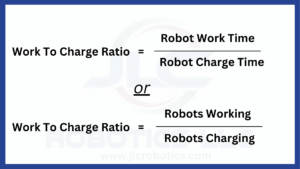
Optimizing your Work to Charge Ratio increases fleet efficiency and saves you money by helping you right-size your robot fleet.
Each mobile robot OEM handles this differently. If there's no an easy way to monitor work to charge ration in your fleet management software, submit a feature request for it!
The potential savings are huge but vary widely by application. Some companies see robot fleet costs drop as much as 35%.
In a 24x7 operation no. Bigger batteries run longer but also take longer to charge, so the Work to Charge Ratio stays the same.
If your shop runs less than three shifts, it's possible that a battery size upgrade will give you enough power to run all day without stopping. Contact us and we'll crunch the numbers with you to see if it'll work in your operation.


